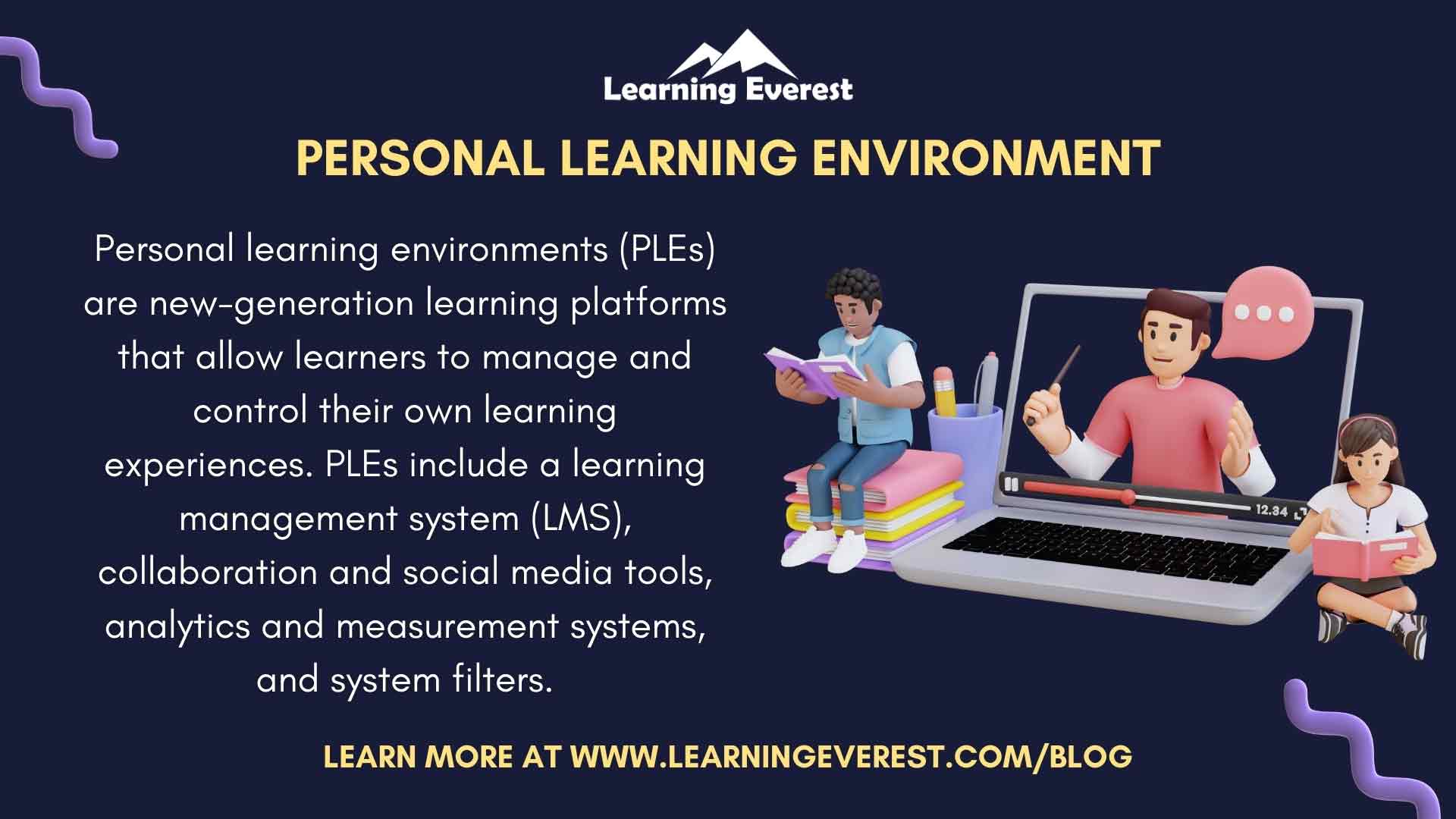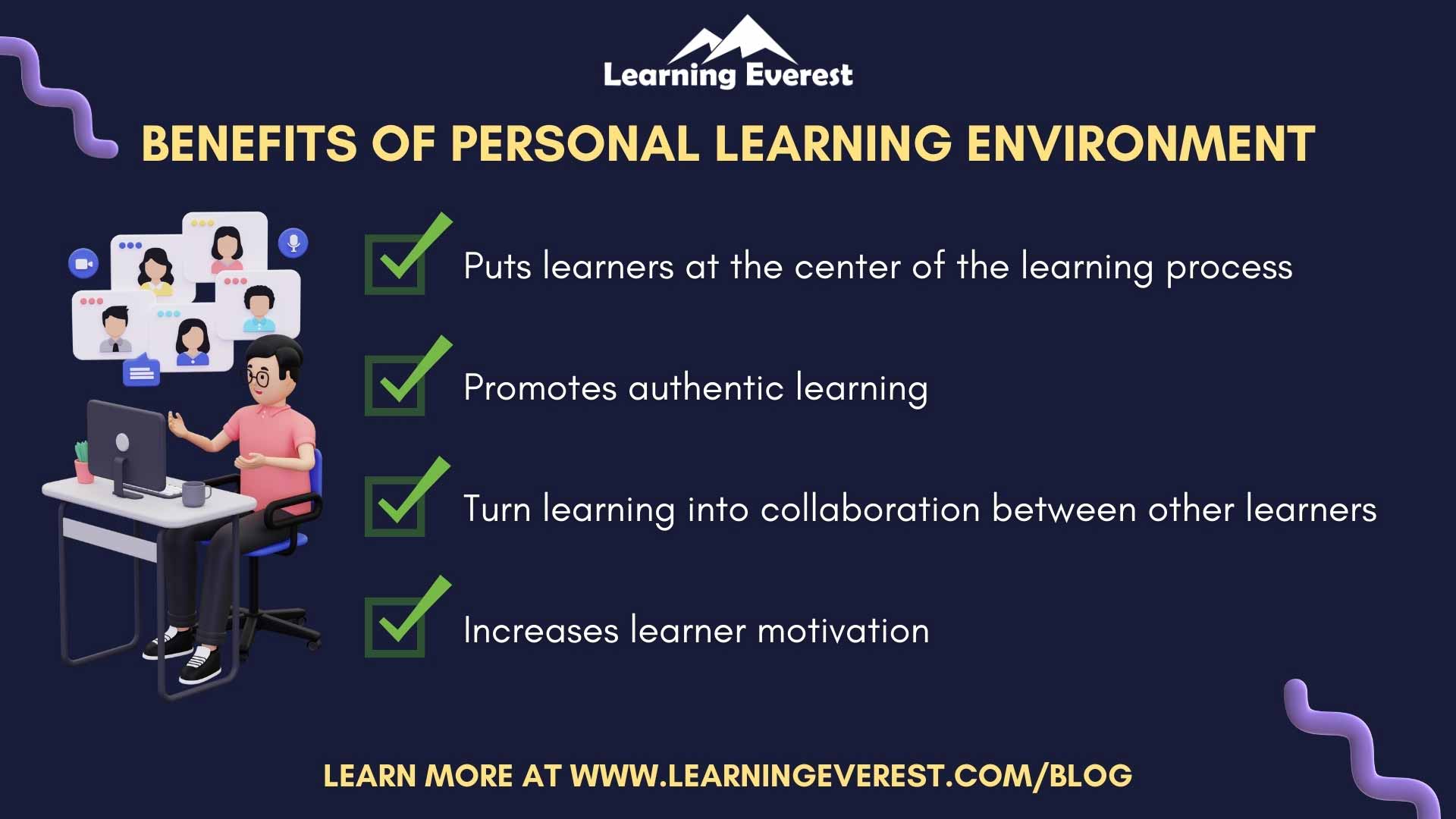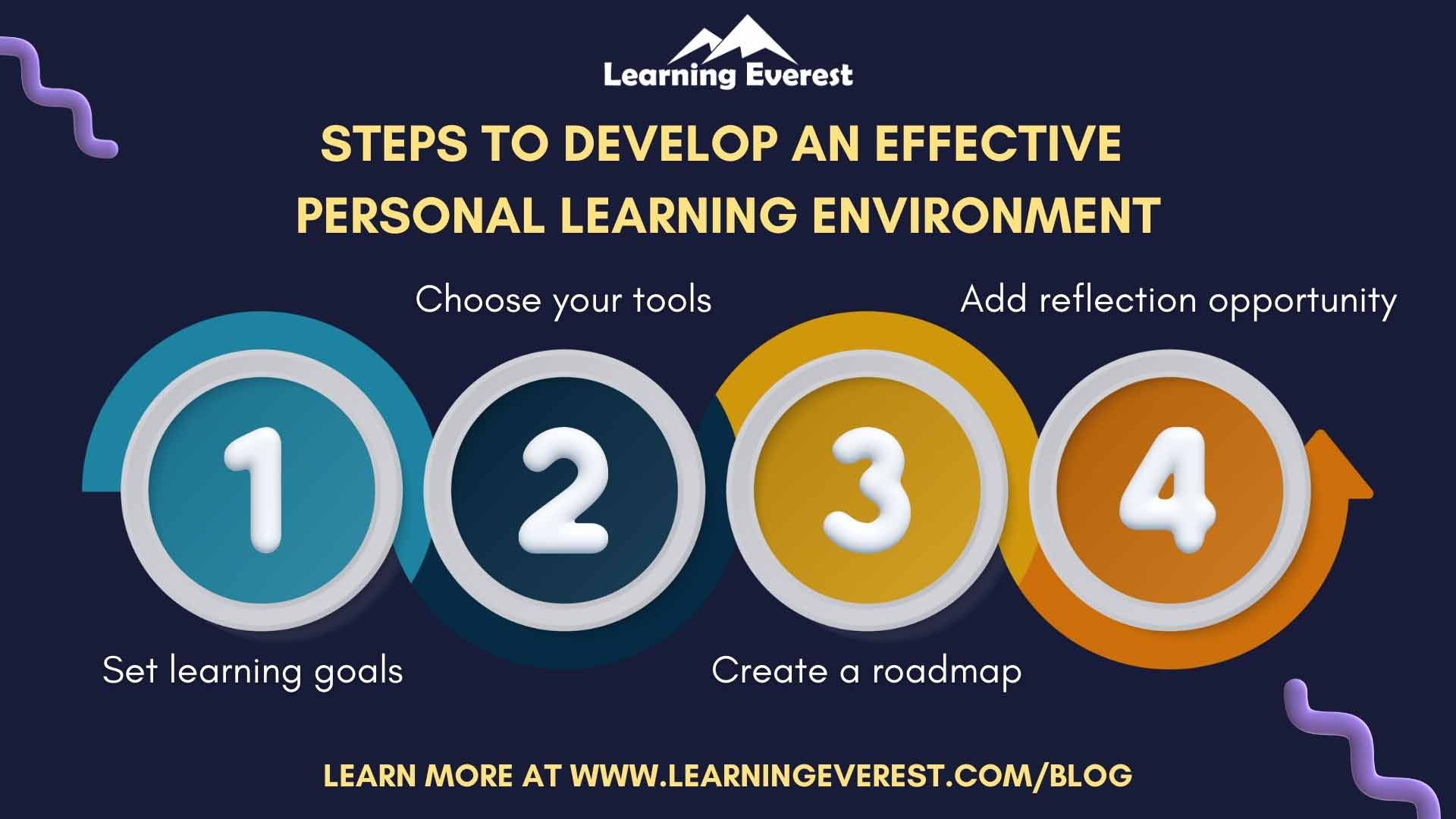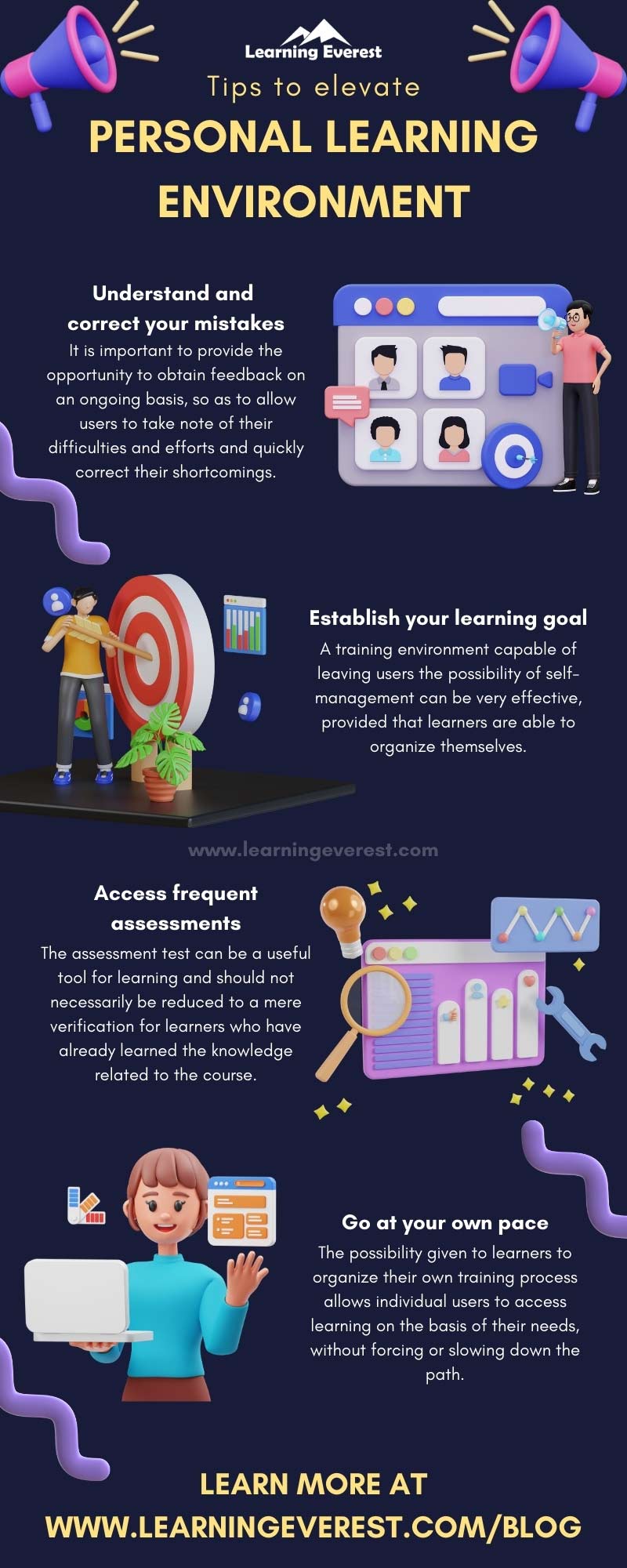Personal learning environments (PLEs) are next-generation learning portals that give learners to manage and control their own learning journey. want to learn more? you are in the right place! Let’s discuss the benefits, the challenges and the process of an effective personal learning environment.
Table of Contents
- What is a personal learning environment (PLE)?
- Why do we need a personal learning environment
- What challenges does the personal learning environment present?
- What’s the difference between the virtual learning environment and the personal learning environment?
- How to develop an effective personal learning environment?
- Infographic
- Knowledge check!
- Frequently Asked Questions (FAQs)
- What does PLE stand for?
- What is an example of a personal learning environment?
- What is the need for a personal learning environment?
What is a personal learning environment (PLE)?
A personal learning environment (PLE) is the space created by an individual to support their own professional and educational growth. As per the definition of the Treccani Encyclopaedia, the term suggests “particular technological environments that individual learners can use to enhance their personal learning and reflection path”. A personal learning environment, therefore, consists of various digital tools and online resources, such as social media, blogs and learning management systems, which allow learners to connect with other learners and provide an infinite series of tools and resources that can be consulted and retrieved by learners in any time and from anywhere.

Personal Learning Environment
The goal of a personal learning environment is to provide learners with control over their own learning journey and access to a variety of learning and development resources, to enable them to achieve the desired educational and professional goals. It represents an environment completely centered on the learner, who is placed at the center of the learning journey and who becomes the main driver in their training.
For this reason, the personal learning environment is usually different that the traditional training and online courses based on an LMS platform maintained mainly by the instructors. But, it is not said that the various types of learning can not meet and intertwine. Although with personal learning environment we mainly mean an online asynchronous environment, the use of other types of resources is not excluded.
Why do we need a personal learning environment
This type of training space provides several advantages:

Benefits of Personal Learning Environment
Benefit no. 1 – Puts learners at the center of the learning process
As we have already said, a Personal learning environment puts the learner at the center of the training and development process, making him the main driver in the collection of information. This includes a constant and continuous commitment on the part of the learners, who must autonomously collect and organize the information they need: it is self-directed asynchronous learning, which requires concentration, awareness and willpower on the part of those who decide to undertake this type of learning course. The protagonists of this learning experience can decide their own training roadmap and interact with other learners or with the trainers. Furthermore, the learner can autonomously access the tools and resources present in the learning space.
Benefit no. 2 – Promotes authentic learning
The personal learning environment allows you to include constructive feedback from industry experts in the field among the activities, which provides an important resource for the learner. In this way, in fact, the user will be able to cross-check his own learning journey thanks to the return of a competent person.
Benefit no. 3 – Turn learning into collaboration between other learners
In an environment where knowledge is omnipresent and only needs to be found, training can no longer be reduced to just a simple transmission of information. Rather, it is a process of collecting, integrating, and recognizing data useful to build one’s own knowledge/skills. For this to be done effectively, however, it is important to collaborate. A personal learning environment is equipped with the technologies necessary for communication and collaboration, making dialogue between learners and the exchange of ideas easier and more immediate.
Benefit no. 4 – Increases learner motivation
The personal learning environment allows learners to tailor their learning journey according to their interests, needs and goals. Learning in a PLE can sometimes lead to feelings of isolation, especially when most interactions occur online. The lack of physical presence of another learner and face-to-face interactions can diminish the sense of community and support that traditional educational environments often provide. However, the personalization of the learning process can be a source of greater motivation, because the learner is driven by a desire to learn that derives from his personal requirements and not from the decisions of others.
What challenges does the personal learning environment present?
However, like any educational model, PLEs come with their own set of drawbacks and challenges.
Challenge 1 – Self-motivation and discipline
A significant challenge within PLEs is the reliance on the learner’s self-motivation and discipline. Without the structured schedules and deadlines of traditional learning environments, learners might struggle to maintain consistent study habits or progress toward their learning goals.
Challenge 2 – Digital literacy requirements
Effective navigation of a PLE demands a certain level of digital literacy. Learners must be capable of identifying, evaluating, and using a huge range of digital tools and resources. This prerequisite can be a barrier for individuals lacking these skills, potentially widening the digital divide.
Challenge 3 – Information overload
The abundance of information and resources available can lead to overload, making it difficult for learners to focus on what is most relevant or valuable for their needs. This can also lead to decision fatigue, where the sheer volume of choices impedes the capability to make informed decisions around what to learn next.
Challenge 4 – Quality and credibility of resources
With the vast collection of online resources available with just a click, ensuring the quality and credibility of educational content can be challenging. Learners must be adept at critically evaluating the information they encounter, a skill that is not innate and needs to be developed over time.
Challenge 5 – Evaluation and Feedback
In traditional settings, educators provide structured feedback to guide learning progress. Within a PLE, obtaining constructive and timely feedback can be more challenging, potentially hindering the learner’s development and adjustment of strategies.
What’s the difference between the virtual learning environment and the personal learning environment?
| Virtual learning environment | Personal learning environment |
|---|---|
| A structured online platform for delivering educational content | A customized learning space created by the learner |
| Institution/instructor controlled | Learner controlled |
| Less flexible | Highly flexible |
| Course-specific learning objectives | Personal learning goals |
How to develop an effective personal learning environment?
For a personal learning environment (PLE) to be effective, it is important to follow a few steps, which will allow you to build an adequate personal environment offered by modern technologies. Here are the steps:

Steps to develop an effective personal learning environment
Let’s discuss them in detail.
Step 1 – Set learning goals
The very first step you need to take is to establish learning areas and training objectives based on educational and professional requirements. The PLE can then include any type of interest and leaves space for sharing and learning of all kinds of information and concepts, in different ways.
Step 2 – Choose your tools
Then you need to determine which tools to use. With the personal learning environment it is possible to create a personalized and customizable learner centric learning space. In this environment, the learner can act dynamically, collect information and develop new knowledge/skills using different tools and technologies and even compare them with others. But the personal learning environment not only implies sharing and communication with other learners, it as well as promotes collaboration for the creation of new information.
Step 3 – Create a roadmap
It is important for you to create a roadmap, which can help you foresee or visualize a concrete picture of the objectives of the learning journey. It helps you find the tools identified as means to achieve your short and long term objectives.
Step 4 – Add reflection opportunity
Moreover, useful moments of reflection can be included in the training and development course. It could be stimulated by surrounding environments that offer a possibility of transforming the knowledge collected, based on your thinking.
What else is important according to you? Tell us in the comments!
Infographic
Knowledge check!
Frequently Asked Questions (FAQs)
What does PLE stand for?
PLE stands for the personal learning environment. It represents a revolutionary shift in the way we approach learning, moving beyond the confines of traditional classrooms and standardized curriculums.
What is an example of a personal learning environment?
An example of a personal learning environment can be social media like, LinkedIn, Twitter or Reddit.
What is the need for a personal learning environment?
The goal of a personal learning environment is to provide learners with control over their own learning journey and access to a variety of learning and development resources, to enable them to achieve the desired educational and professional goals.






